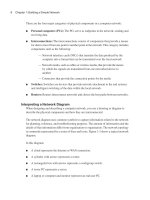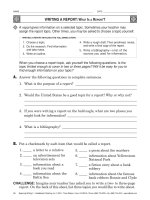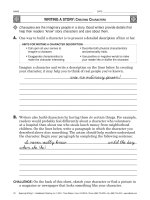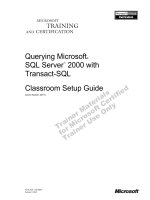Tài liệu Beginning Microsoft Office Live P2 pptx
Bạn đang xem bản rút gọn của tài liệu. Xem và tải ngay bản đầy đủ của tài liệu tại đây (533.57 KB, 10 trang )
If this book makes me rich beyond belief, I may decide to divide my company into eastern
a
nd western divisions, and have a separate web site for each. I can then create
s
ubdomains
called east.acxede.net and west.acxede.net and call web servers in those subdomains www.
east.acxede.net
and www.west.acxede.net, respectively.
In the United Kingdom, authorities have adopted such a system. The TLD,
uk, is divided
into several subdomains. For example, the subdomain for commercial enterprises is
co.uk,
and that for educational institutions is ac.uk. If I were to register my domain in the United
Kingdom, I would register it as
acxede.co.uk, and my web server would be www.acxede.co.uk.
Translating Domain Names to IP Addresses
While people prefer names to numbers, the reverse is true for computers. People-friendly
names, such as
www.acxede.net, which you type into your browser, must be translated into
computer-friendly addresses, such as
216.246.42.123, which web servers understand.
With the help of specialized software called the Domain Name System (DNS), computer
names are automatically translated on the Internet into their IP addresses. Whenever you type
www.acxede.net into your browser, DNS software running on your computer looks up the IP
address of the computer whose name is
www.acxede.net and establishes a connection to it
using its IP address.
The DNS software on your computer doesn’t store all possible computer names and their
IP addresses locally. This cross-reference is, in fact, distributed across the Internet. Each
domain has a special server called a
domain name server that stores the names of all comput-
ers and their IP addresses in that domain.
Large organizations that maintain their own Internet infrastructure have their own
domain name servers. If you host your domain with a hosting service provider, the HSP will
maintain the domain name server on your behalf.
FAQ
How Does a Web Page Appear in My Browser When I Enter Its Address?
Let’s say you type into your browser. This string is the web
address of the page
default.aspx, which resides on a web server named www.acxede.net.
Some people refer to a web address as a URL, which stands for Uniform Resource Loca
tor.
No ma
tter
what you call it, it still points to the location of
default.aspx on the Web. Your browser splits this string
into three parts:
the protocol, the hostname, and the resource name.
The first part,
http://,
is called
the
protocol.
Y
ou can think of a protocol as a method of deliver
y
.
Just
as an item you buy online can be shipped to you via United States Postal Service (USPS), FedEx, or some
other shipping method,
a file you request from a server on the Internet can be sent to you via one of the
a
vailable protocols.
The
W
orld
Wide Web uses the
http protocol.
The last part,
default.aspx, is called the resource name. It is the name of a resource, such as a web
pa
ge,
a file, or an image, that resides on the web server.
The part in the
middle,
www.acxede.com,
is the
hostname or the name of the web ser
ver on which the
resource resides.
CHAPTER 2 ■ GETTING READY TO SIGN UP 23
8792ch02final.qxd 8/29/07 9:35 PM Page 23
Your computer must open a connection to the computer www.acxede.net in order to download the
w
eb page. To open the connection, your computer must know
w
ww.acxede.net
’
s IP address. Let's say it
doesn't know the IP address. It now has to ask a domain name server for help.
The domain name server closest to your computer belongs to your ISP, which connects your computer
to the Internet. Your computer establishes a connection to it. If computers could talk, here’s how their conver-
sation would go:
Your Computer: Hi! Do you know www.acxede.net’s IP address?
Your ISP’s name server: Actually, I don’t, but I can ask the name server of the .net TLD. I know its IP
address. Hold on for a moment.
Your ISP’s name server then puts your computer on hold and establishes a connection with .net TLD’s
domain name server on the other line.
Your ISP’s name server: Hi! Do you know www.acxede.net’s IP address?
.net TLD’s domain name server: I’m really busy right now.There are too many domains in .net TLD,
and I’m having a tough time keeping track of everyone’s IP address. But here’s the IP address of
acxede.net’s domain name server: 66.55.44.22. You can ask him.
Your ISP’s name server: Thanks!
Your ISP’s name server then disconnects from .net TLD’s name server and establishes a connection
with
acxede.net’s domain server using the IP address it just received.
Your ISP’s name server: Hi! Do you know www.acxede.net’s IP address?
Acxede.net’s name server: Of course I do! It’s one of our servers. Its IP address is
216.246.42.123.
Your ISP’s name server: Okay, thanks!
It disconnects from acxede.net’s domain name server and starts talking to your computer again.
Your ISP’s name server: Okay, here it is: 216.246.42.123.
Your computer: Thanks!
Using the IP address it just received, your computer establishes a connection with
www.acxede.net
and requests the file default.aspx (the home page) from it via the http protocol. www.acxede.net
obliges, and the page loads in your browser.
“Hey! Wait a minute!” you might say. “How did the ISP’s name server know the IP address of
.net
TLD’s name server?”
The answer is rather anticlimactic. IP addresses of TLD’s name servers are built into the DNS. All
domain name servers know them. But that still leaves one question unanswered: how does
.net TLD’s name
server know the IP address of the
acxede.net domain’s name server?
The ans
wer is: courtesy of
acxede.net’
s domain registration records with its registrar. Every domain’s
registration records include the IP addresses of its name servers. These records are part of the DNS, and
TLD’s name servers can access them.
This is, of course, a simplified version of what goes on behind the scenes, but it captures the essence of
the process.
CHAPTER 2 ■ GETTING READY TO SIGN UP24
8792ch02final.qxd 8/29/07 9:35 PM Page 24
Office Live and Your Domain
When you open a new Office Live account, you can choose how you want Office Live to work
with your domain. You have two options:
• Register a new domain name through Office Live during sign-up.
• Register a domain name with another registrar and change the name servers in your
domain records to Office Live’s name servers—a process known as
domain redirection.
Registering a New Domain Name Through Office Live
Office Live seeks to take the bite out of this whole business of registrars, hosting providers,
and name servers. When you open a new account and opt to register a new domain, Office
Live automatically registers your domain, establishes your hosting account, and sets the
name servers in your domain registration records. Best of all, Microsoft foots the bill for the
registration.
Office Live has its own hosting facilities and name servers, but Microsoft is not a registrar.
So Office Live has teamed up with a registrar called Melbourne IT.
■Note Microsoft officially became an accredited domain name registrar on October 31, 2006. But just as
James Bond doesn’t go on a killing spree simply because he has a license to kill, Microsoft hasn’t started
registering domain names even though it is licensed to do so. Melbourne IT is still the registrar for all
Office Live domain registrations, although that may change in the future.
Melbourne IT is the sole registrar for new domains registered with Office Live; you can’t
choose any other registrar. After registration, Office Live is in charge of your domain records.
You must route changes to your domain records through Office Live’s customer service.
FAQ
Who Really Owns My Domain Name—Office Live or Me?
You do. Although an Office Live account deprives you of the flexibility of making changes to your domain
records, Microsoft compensates you for your sacrifice by paying your registration charges.
Still, you own the domain and if, for any reason, you wish to part ways with Office Live, you can cer-
tainly do so.
This scheme of things is quite restrictive for those who are accustomed to managing their
o
wn domain r
ecor
ds
. For the rest, it’s wonderfully simple.
CHAPTER 2 ■ GETTING READY TO SIGN UP 25
8792ch02final.qxd 8/29/07 9:35 PM Page 25
Choosing a Domain Name
Finding a name you like that is still up for grabs is more difficult than you might imagine. Rest
assured that any name with three letters or less is already taken. So is almost any word in the
dictionary. Office Live makes matters worse for you because it only hosts web sites with
.com,
.net, or .org extensions. This narrows your choices considerably.
■Note If you live in the United Kingdom, Japan, or the European Union, Office Live will let you register
domain names with .co.uk, .jp, and .eu extensions, respectively.
After a cursory search for a domain name, you will quickly arrive at that famous conclu-
sion:
all the good ones are taken! Unfortunately, you can’t proceed with opening your Office
Live account without a domain name.
TIPS FROM THE TRENCHES
How to Pick a Good Domain Name
Finding a domain name that’s catchy, memorable, and relevant to your business is not easy. Chances are
you’ll have to settle for a name that you aren’t exactly nuts about. Here are a few tips on making the best of
the situation:
• The name of your business is obviously the best domain name you can get. But more often than not, it
won’t be available. You can increase the odds in your favor by adding words before or after your busi-
ness name. A few years ago, I wanted the name
websites.com. It was already taken, but
designerwebsites.com was available.
• If you’re starting a new business, you may want to settle on a domain name before deciding on a name
for your new venture.
• Include keywords in your domain name—for example,
designerwebsites.com rather than
rahulsbusiness.com. Someone who wants a web site designed isn’t likely to search for rahul’s
business
. Chances of the person searching for web site designers or something similar are much
grea
ter.
Besides, search engines are more likely to place your web site higher in search results if your
domain name contains keywords.
•
Although easier said than done, look for a short domain name.
Short names are easier to remember.
•
Try to register a domain name with a
.com extension.
People remember it more easily than
.net or
.org extensions.
Several online tools are available to help you brainstorm for a domain name. The “Hands-
On Lab” sidebar on the next page steps you through searching for a domain name with one
such tool.
CHAPTER 2 ■ GETTING READY TO SIGN UP26
8792ch02final.qxd 8/29/07 9:35 PM Page 26
HANDS-ON LAB
Brainstorm for a Domain Name Online
A good place to look for domain names is www.domainsbot.com. To find a domain name using the tools at
this web site, follow these steps:
1. Point your browser at www.domainsbot.com. You should see the web page shown in the following
figure.
CHAPTER 2 ■ GETTING READY TO SIGN UP 27
8792ch02final.qxd 8/29/07 9:35 PM Page 27
2. Enter a keyword or a phrase related to your web site’s topic. You can enter the name of your business
or a short phrase that describes your web site. In this example, I have entered the phrase
office live
b
ook
,
because I want a companion site for this book. As you type the phrase, DomainsBot gets to work.
A couple of seconds after you’re done, you should see a pop-up box like the one shown in the follow-
ing figure.
CHAPTER 2 ■ GETTING READY TO SIGN UP28
8792ch02final.qxd 8/29/07 9:36 PM Page 28
3. The pop-up box shows a list of available names based on the phrase you entered. If you don’t like any
of them, click the
Search button. You should see a web page like the one in the following figure.
4. This page displays crea
tive reitera
tions of the phrase you entered in the search box on the previous
page. Check or uncheck boxes in the
LiveBot panel to the right to expand or narrow down choices
tha
t DomainsBot presents to you.
DomainsBot can serve up better choices if you add synonyms to your keywords using the
Add Synonym links in the LiveBot panel.
Finding the perfect domain name for your web site is usually a long process. Don’t expect to get it done
in a few minutes. In fact, you may spend a good bit of time muttering four-letter words under your breath (or
questioning the pedigree of people who have snapped up domain names you would give your left hand for)
before you find a domain name that’s good—or, at least, good enough—for your purposes.
CHAPTER 2 ■ GETTING READY TO SIGN UP 29
8792ch02final.qxd 8/29/07 9:36 PM Page 29
Domain Registration and Privacy
Along with name server information, your domain records contain your contact information,
which is available to anyone who wants it. During the Internet’s early days, this information
helped solve traffic problems, because anyone could get in touch with you regarding your
domain and your servers.
These days, it’s more of a nuisance than a good thing. It’s a gold mine for spammers. Regis-
tering a domain instantly qualifies you to receive offers for everything that is illegal, immoral,
or carries a life sentence. To address this issue, many registrars offer private domain registration
for a fee.
When you register a private domain, your domain registration records contain your regis-
trar’s contact information. Therefore, anyone trying to contact you ends up sending a message
to your registrar. If the message is relevant to your domain, the registrar forwards it to you. If
it’s spam, the registrar discards it.
Although you have to pay your registrar a few additional dollars every year for the privi-
lege of receiving spam on your behalf, private registrations are hugely popular. Unfortunately,
Melbourne IT doesn’t offer private registrations to Office Live domains.
■Caution Offers for cheap narcotics aren’t the only kind of spam you can expect. You’ll also receive offers
from competing registrars for transferring your domain registration to them. Their wording is often mislead-
ing, and their tone can be anywhere from a polite request to a veiled threat.
You can safely shred such letters or delete such e-mails. Microsoft pays for your domain registration,
and the renewal is automatic. You don’t have to lift a finger to manage your domain.
Redir
ecting a Domain to Your Office Live Account
If you already own the domain name of your dreams, you can redirect it to your Office Live
account instead of choosing a new one. Domain redirection spares you the agony of finding a
new domain name, but you have to pay the annual registration fees yourself; Microsoft won’t
foot the bill.
If you redirect an existing domain to Office Live, you’ll receive instructions on changing
domain name ser
vers in your domain’s registration records while signing up.
CHAPTER 2 ■ GETTING READY TO SIGN UP30
8792ch02final.qxd 8/29/07 9:36 PM Page 30
FAQ
Can I Transfer My Domain to Office Live Instead of Redirecting It?
Transferring a domain means firing your current registrar and entrusting your domain’s registration records to
another registrar. Many people want to transfer their domains to Melbourne IT in order to avoid paying
domain registration fees.
Unfortunately, Office Live doesn’t allow domain transfers. Microsoft is not trying to save money by
refusing transfers; it simply doesn’t want unnecessary headaches.
Transferring domains is a tricky process. You have to monitor the transfer closely and fix problems if
they arise during the process. If something goes wrong during the transfer, your domain will go into a state of
suspended animation. Nobody can visit your web site, and you won’t be able send or receive e-mail.
During Office Live’s early days, domain transfers were allowed. Many people initiated transfers of their
domains but didn’t follow up on them. As a result, their domains remained in a limbo for long periods of time.
This frustrated quite a few people and generated plenty of undesirable publicity for Office Live, so Microsoft
stopped accepting domain transfers for Office Live accounts.
TIPS FROM THE TRENCHES
Write Down Your Domain Name
Write down the domain name you’ll use for your Office Live account here:
Domain name for your new Office Live web site: ________________________________________
Here’s why.
Brainstorming for a domain name can take a long time. Most people consider dozens of names before
finally choosing one. It is not uncommon to choose a domain name late one night and forget which one you
chose the next morning.
A friend of mine signed up for Office Live with a new domain name and couldn’t remember it a couple
of days later. The good folks in Office Live’s customer service department had to look it up based on his name
and credit-card number
,
and it took a couple of days.
Understanding Windows Live IDs
Next, you must choose a single sign-on credential, called Windows Live ID, to sign in to your
Office Live account.
A single sign-on credential is a single user ID/password combination that allows you to
access several computer or online accounts. Windows Live ID is Microsoft’s single sign-on cre-
dential. With a Windows Live ID, you can sign in to any of Microsoft’s web sites, and a few
other web sites such as
www.mcafee.com, which participate in Microsoft Passport Network.
CHAPTER 2 ■ GETTING READY TO SIGN UP 31
8792ch02final.qxd 8/29/07 9:36 PM Page 31
Why Do You Need Single Sign-On Credentials?
Generally speaking, you have to create sign-on credentials on every web site that requires you
to sign or log in. Each web site has different rules for user IDs and passwords. Everyone knows
w
hat a nightmare it is keeping track of several user IDs and passwords.
The Windows Live ID authentication system seeks to solve this problem. The system has
two components: an account information database and an authentication service. You create
sign-on credentials with the Windows Live ID web site, which become a part of Windows Live
ID’s account information database. Then you can use your Windows Live ID to sign on to any
web site that uses Windows Live ID’s authentication service.
All Microsoft web sites use Windows Live ID for authentication. Therefore, you can use a
Windows Live ID to sign on to any of them. For instance, I use my Windows Live ID to manage
my Office Live Basics web site, my Microsoft Partner Program membership, my Microsoft
Office Online account, my Microsoft Learning subscription, and my Windows Live Hotmail
account.
A single ID to access all your accounts makes a lot of sense. In fact, Windows Live IDs are
not new. They’ve been around for years, way back when they were called Passport IDs
(another case of MINFU). The network of web sites that used Passport IDs for authenticating
users was called the Passport Network. Microsoft’s vision was to create a single sign-on cre-
dential for all web commerce. With that goal in mind, Microsoft tried, for many years, to enlist
other web sites to adopt Passport authentication, but with little success. User information is
an important asset for businesses, and few were willing to let Microsoft manage it, despite
Microsoft’s good intentions.
Like most authentication systems, Windows Live ID requires you to have an ID and a
password. The ID is typically your e-mail address, so be advised that you need to pick one in
order to create a Windows Live ID.
■Note You can create a Windows Live ID without an e-mail address. It’s called a Limited Account. But I will
restrict this discussion to the more established convention of using e-mail addresses as user IDs.
Choosing a Windo
ws Live ID for Your Office Live Account
Even if you already have a Windows Live ID, Office Live will ask you to create a new one for
your account when you sign up. The ID must be an e-mail address in the domain you associ-
ate with your Office Live account.
CHAPTER 2 ■ GETTING READY TO SIGN UP32
8792ch02final.qxd 8/29/07 9:36 PM Page 32









